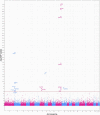Genome-Wide Identification of Rare and Common Variants Driving Triglyceride Levels in a Nevada Population
- PMID: 33763119
- PMCID: PMC7982958
- DOI: 10.3389/fgene.2021.639418
Genome-Wide Identification of Rare and Common Variants Driving Triglyceride Levels in a Nevada Population
Abstract
Clinical conditions correlated with elevated triglyceride levels are well-known: coronary heart disease, hypertension, and diabetes. Underlying genetic and phenotypic mechanisms are not fully understood, partially due to lack of coordinated genotypic-phenotypic data. Here we use a subset of the Healthy Nevada Project, a population of 9,183 sequenced participants with longitudinal electronic health records to examine consequences of altered triglyceride levels. Specifically, Healthy Nevada Project participants sequenced by the Helix Exome+ platform were cross-referenced to their electronic medical records to identify: (1) rare and common single-variant genome-wide associations; (2) gene-based associations using a Sequence Kernel Association Test; (3) phenome-wide associations with triglyceride levels; and (4) pleiotropic variants linked to triglyceride levels. The study identified 549 significant single-variant associations (p < 8.75 × 10-9), many in chromosome 11's triglyceride hotspot: ZPR1, BUD13, APOC3, APOA5. A well-known protective loss-of-function variant in APOC3 (R19X) was associated with a 51% decrease in triglyceride levels in the cohort. Sixteen gene-based triglyceride associations were identified; six of these genes surprisingly did not include a single variant with significant associations. Results at the variant and gene level were validated with the UK Biobank. The combination of a single-variant genome-wide association, a gene-based association method, and phenome wide-association studies identified rare and common variants, genes, and phenotypes associated with elevated triglyceride levels, some of which may have been overlooked with standard approaches.
Keywords: GWAS; PheWAS; rare variant analysis; triglycerides; whole exome sequencing.
Copyright © 2021 Read, Schlauch, Lombardi, Cirulli, Washington, Lu and Grzymski.
Conflict of interest statement
JL, EC, and NW are employees of Helix Opco, LLC. The remaining authors declare that the research was conducted in the absence of any commercial or financial relationships that could be construed as a potential conflict of interest.
Figures


Similar articles
-
A Comprehensive Genome-Wide and Phenome-Wide Examination of BMI and Obesity in a Northern Nevadan Cohort.G3 (Bethesda). 2020 Feb 6;10(2):645-664. doi: 10.1534/g3.119.400910. G3 (Bethesda). 2020. PMID: 31888951 Free PMC article.
-
Loss-of-function mutations in APOC3, triglycerides, and coronary disease.N Engl J Med. 2014 Jul 3;371(1):22-31. doi: 10.1056/NEJMoa1307095. Epub 2014 Jun 18. N Engl J Med. 2014. PMID: 24941081 Free PMC article.
-
UK Biobank Whole-Exome Sequence Binary Phenome Analysis with Robust Region-Based Rare-Variant Test.Am J Hum Genet. 2020 Jan 2;106(1):3-12. doi: 10.1016/j.ajhg.2019.11.012. Epub 2019 Dec 19. Am J Hum Genet. 2020. PMID: 31866045 Free PMC article.
-
The challenges, advantages and future of phenome-wide association studies.Immunology. 2014 Feb;141(2):157-65. doi: 10.1111/imm.12195. Immunology. 2014. PMID: 24147732 Free PMC article. Review.
-
Variation of candidate genes in triglyceride metabolism.J Cardiovasc Risk. 2000 Oct;7(5):309-15. doi: 10.1177/204748730000700503. J Cardiovasc Risk. 2000. PMID: 11143760 Review.
Cited by
-
Naturally occurring metals in unregulated domestic wells in Nevada, USA.Sci Total Environ. 2022 Dec 10;851(Pt 2):158277. doi: 10.1016/j.scitotenv.2022.158277. Epub 2022 Aug 24. Sci Total Environ. 2022. PMID: 36029812 Free PMC article.
-
Pan-Cancer Profiling and Digital Pathology Analysis Reveal Negative Prognostic Biomarker ZPR1 Associated with Immune Infiltration and Treatment Response in Hepatocellular Carcinoma.J Hepatocell Carcinoma. 2023 Aug 9;10:1309-1325. doi: 10.2147/JHC.S415224. eCollection 2023. J Hepatocell Carcinoma. 2023. PMID: 37581094 Free PMC article.
-
Using phenome-wide association studies and the SF-12 quality of life metric to identify profound consequences of adverse childhood experiences on adult mental and physical health in a Northern Nevadan population.Front Psychiatry. 2022 Oct 6;13:984366. doi: 10.3389/fpsyt.2022.984366. eCollection 2022. Front Psychiatry. 2022. PMID: 36276335 Free PMC article.
-
A study of impulsivity and adverse childhood experiences in a population health setting.Front Public Health. 2024 Dec 4;12:1447008. doi: 10.3389/fpubh.2024.1447008. eCollection 2024. Front Public Health. 2024. PMID: 39697282 Free PMC article.
-
A Gene Variation at the ZPR1 Locus (rs964184) Interacts With the Type of Diet to Modulate Postprandial Triglycerides in Patients With Coronary Artery Disease: From the Coronary Diet Intervention With Olive Oil and Cardiovascular Prevention Study.Front Nutr. 2022 Jun 17;9:885256. doi: 10.3389/fnut.2022.885256. eCollection 2022. Front Nutr. 2022. PMID: 35782928 Free PMC article.
References
-
- Ariza M.-J., Sánchez-Chaparro M. -Á, Barón F.-J., Hornos A.-M., Calvo-Bonacho E., Rioja J., et al. (2010). Additive effects of LPL, APOA5 and APOEvariant combinations on triglyceride levels and hypertriglyceridemia: results of the ICARIA genetic sub-study. BMC Med. Genet. 11:66. 10.1186/1471-2350-11-66 - DOI - PMC - PubMed
-
- Benjamini Y., Hochberg Y. (1995). Controlling the false discovery rate: a practical and powerful approach to multiple testing. J. R. Stat. Soc. B Stat. Methodol. 57 289–300.
Grants and funding
LinkOut - more resources
Full Text Sources
Other Literature Sources
Miscellaneous

